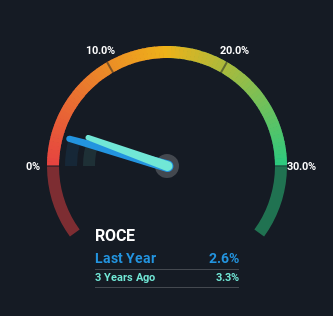- United States
- /
- Specialty Stores
- /
- NYSE:CANG
Some Investors May Be Worried About Cango's (NYSE:CANG) Returns On Capital

When it comes to investing, there are some useful financial metrics that can warn us when a business is potentially in trouble. Typically, we'll see the trend of both return on capital employed (ROCE) declining and this usually coincides with a decreasing amount of capital employed. Trends like this ultimately mean the business is reducing its investments and also earning less on what it has invested. So after we looked into Cango (NYSE:CANG), the trends above didn't look too great.
Return On Capital Employed (ROCE): What Is It?
For those that aren't sure what ROCE is, it measures the amount of pre-tax profits a company can generate from the capital employed in its business. Analysts use this formula to calculate it for Cango:
Return on Capital Employed = Earnings Before Interest and Tax (EBIT) ÷ (Total Assets - Current Liabilities)
0.026 = CN¥101m ÷ (CN¥4.6b - CN¥778m) (Based on the trailing twelve months to December 2023).
Thus, Cango has an ROCE of 2.6%. Ultimately, that's a low return and it under-performs the Specialty Retail industry average of 13%.
View our latest analysis for Cango

While the past is not representative of the future, it can be helpful to know how a company has performed historically, which is why we have this chart above. If you want to delve into the historical earnings , check out these free graphs detailing revenue and cash flow performance of Cango.
What The Trend Of ROCE Can Tell Us
The trend of ROCE at Cango is showing some signs of weakness. The company used to generate 4.8% on its capital five years ago but it has since fallen noticeably. In addition to that, Cango is now employing 33% less capital than it was five years ago. The fact that both are shrinking is an indication that the business is going through some tough times. If these underlying trends continue, we wouldn't be too optimistic going forward.
Our Take On Cango's ROCE
In summary, it's unfortunate that Cango is shrinking its capital base and also generating lower returns. It should come as no surprise then that the stock has fallen 38% over the last five years, so it looks like investors are recognizing these changes. With underlying trends that aren't great in these areas, we'd consider looking elsewhere.
If you want to know some of the risks facing Cango we've found 2 warning signs (1 makes us a bit uncomfortable!) that you should be aware of before investing here.
While Cango isn't earning the highest return, check out this free list of companies that are earning high returns on equity with solid balance sheets.
New: AI Stock Screener & Alerts
Our new AI Stock Screener scans the market every day to uncover opportunities.
• Dividend Powerhouses (3%+ Yield)
• Undervalued Small Caps with Insider Buying
• High growth Tech and AI Companies
Or build your own from over 50 metrics.
Have feedback on this article? Concerned about the content? Get in touch with us directly. Alternatively, email editorial-team (at) simplywallst.com.
This article by Simply Wall St is general in nature. We provide commentary based on historical data and analyst forecasts only using an unbiased methodology and our articles are not intended to be financial advice. It does not constitute a recommendation to buy or sell any stock, and does not take account of your objectives, or your financial situation. We aim to bring you long-term focused analysis driven by fundamental data. Note that our analysis may not factor in the latest price-sensitive company announcements or qualitative material. Simply Wall St has no position in any stocks mentioned.
About NYSE:CANG
Cango
Operates an automotive transaction service platform that connects dealers, original equipment manufacturers, financial institutions, car buyers, insurance brokers, and companies in the People’s Republic of China.
Flawless balance sheet and undervalued.
Similar Companies
Market Insights
Community Narratives


